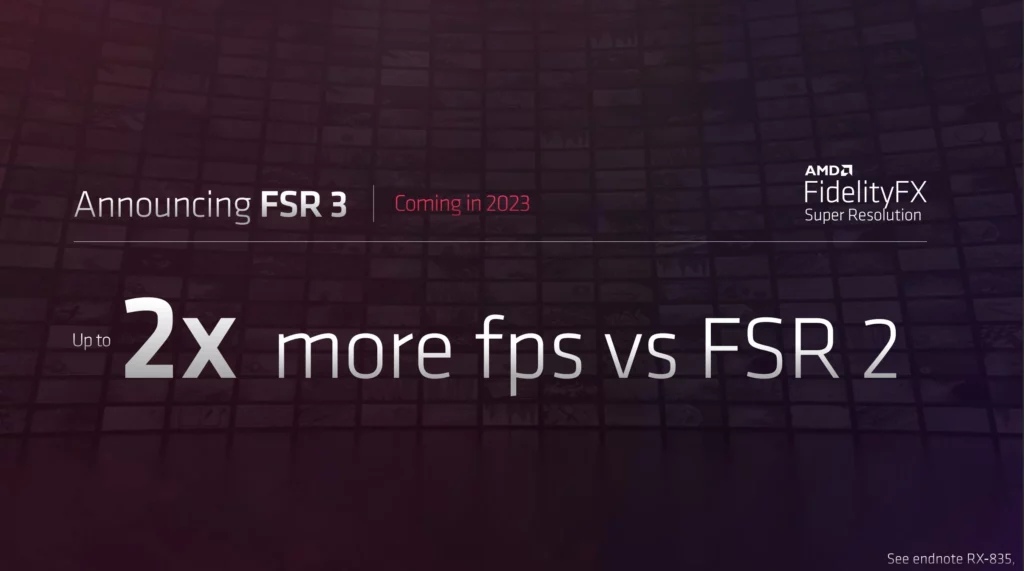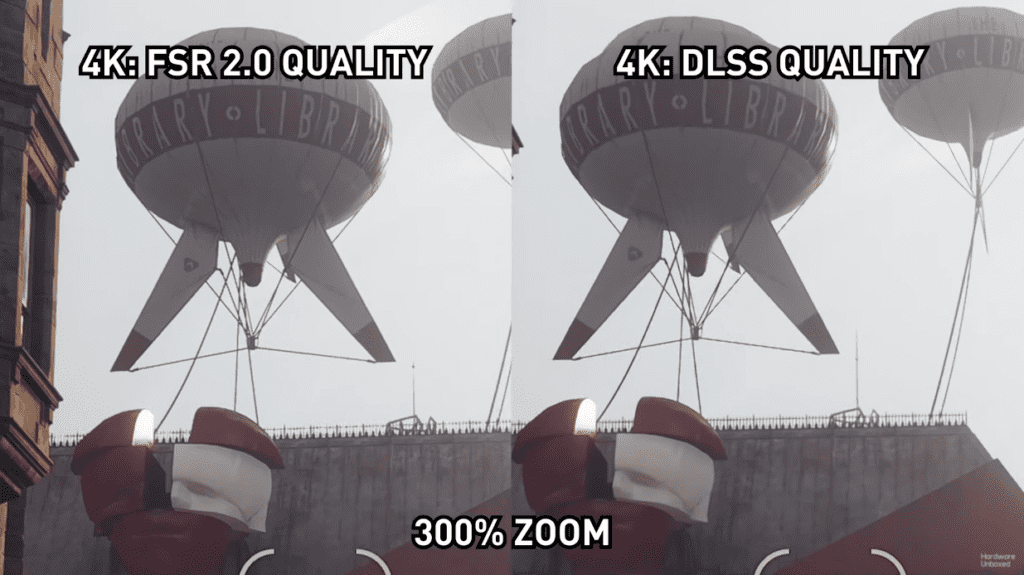During the Computex event in 2021, AMD finally announced what numerous gamers had been expecting: a response to NVIDIA’s DLSS (Deep Learning Super Sampling) technology.
This solution is called FidelityFX Super Resolution, or FSR for brief.
Below, we’ll briefly discuss DLSS to ensure that everyone properly understands the concept and then explain FSR in detail.
Let’s dive into it!
Table of ContentsShow
What Is DLSS?
DLSS was in development for a prolonged time, and it was released paired with Nvidia’s RTX 2000 because it’s reliant on Tensor Cores which can only be found in modern RTX GPUs, including the 3000 series.
With the power of this hardware and deep learning, DLSS performs an upscale of lower-resolution images and outputs pictures at substantially higher resolutions.
This results in substantially superior performance while providing the same level of image quality (or at least minimally diminished quality).
At first, DLSS wasn’t all that impressive because the first iterations of this technology were found to lose too much quality. The additional FPS were welcomed, but users were left with fuzzy and smeared images, as seen in Control and Battlefield V.
The changes that came with the release of DLSS 2.0 were a welcome innovation. The performance uplift was equivalent, but, in some instances, games looked even better than when played at native resolution.
Today, DLSS can be found in many notable competitive and individual-player games, including Call of Duty Warzone and Black Ops Cold War, Cyberpunk 2077, Death Stranding, Watch Dogs: Legion, and several others.
Currently, the main problem with DLSS is that it requires developers to invest a significant amount of time and effort to add it to their games.
But this is where FSR emerges!
Updates +
- March 08, 2023: Added news regarding FSR 3, updated games list and more.
- August 08, 2022: Added news that FSR 2.0 can now easily be added to games thanks to its open-source code.
- June 20, 2022: Added a bunch of new games and specified which support FSR 2.0.
- May 13, 2022: Added image and performance comparison between FSR 2.0 and DLSS.
- April 02, 2022: Reworked article to fit in FSR 2.0
- December 15, 2021: Added even more games for FSR.
- September 2, 2021: Added Myst and Black Desert Online
- August 3, 2021: Added more games supporting FSR
What Is FidelityFX Super Resolution?
Unlike DLSS, FSR does not rely on hardware, which provides both benefits and drawbacks against its competition.
The primary issue with FSR is its inability to maintain image quality, which was improved with the updated FSR 2.0 version. More on that later.
NVIDIA utilizes machine learning (powered by Tensor Cores) to fill in what the picture lacks when said image is set at a decreased resolution.
FSR uses spatial upscaling, which takes data from the current low-resolution frame and then upscales it to a higher-resolution render. However, this isn’t perfect as spatial upscaling can substantially impact image quality on lower FSR settings.
FSR 2.0
FSR 2.0, on the other hand, uses temporal upscaling. This way, FSR gets more information to process, leading to a substantially superior-quality image.
Just like NVIDIA’s 2.0 update for DLSS, FSR 2.0 delivered improved image quality to FSR 1 and considerably less motion blur, ghosting, jittering, etc.
**Here’s Digital Foundry’s thorough test of FSR 1.0 vs FSR 2.0 vs DLSS 2.0 vs Native:**
Keep in mind that both AMD and NVIDIA are constantly improving their upscaling technologies, so the picture quality, ghosting, jittering, and other visual defects have enhanced since this video.
FSR 3
NVIDIA DLSS 3/Frame Generation left AMD’s FSR technology in the dust even though it only works with the expensive RTX 4000 GPUs.
Fortunately, it appears that AMD might be planning a comparable solution with FSR 3.
AMD announced that FSR 3 will offer up to 2x superior performance compared to FSR 2.0, which is exactly how NVIDIA promoted DLSS 3.

AMD will most likely announce their upcoming FSR 3 update during GDC 2023 event on March 23.
We’re thrilled to see how FSR 3 will change gaming and whether it will work with numerous graphics cards rather than with just RX 7000.
Hardware Support
One notable advantage FSR has over Nvidia’s upscaling solution is hardware compatibility. While DLSS is locked to RTX hardware only, FSR can be used on various GPU series from Team Red and Team Green.
Here’s a snippet from Hardware Unboxed in which they are examining multiple old GPUs with FSR 2.0:
As we can see, GPUs from several years ago, like the RX 570 and GTX 1070 Ti, function well with FSR. The performance enhancement might not be as significant as on newer GPUs, but still a pleasant boost in FPS.
Other GPUs from the RTX 2000, GTX 1000, RX 5000, RX 500, and numerous additional can use FSR 2.0.
Game Support
Even more captivating is that, as FSR improves over the years, the in-game implementation might become much easier for game developers.
In fact, the implementation process is already quite uncomplicated. There are some reports that a developer was able to add FSR into their game in just a few hours.
Recently, AMD released the source code for their FSR technology, opening up many possibilities. Believe it or not, modders already utilize this source code to add FSR 2.0 to games that have DLSS, but don’t support FSR.
Currently, such mods are available for multiple games including Red Dead Redemption 2, Dying Light 2 Stay Human, Guardians of the Galaxy, Cyberpunk 2077, Metro Exodus, and additional titles.
While modded FSR may not be as stable as official FSR support, it still shows us exactly how flexible AMD’s upscaling tech is. We imagine that many moddable games in the future can and will have FSR 2.0.
Either way, numerous leading studios/games already have FSR 2.0 and will continue updating it for enhanced performance and visual quality.
Compilation of several famous games that support FSR:

You can check out all supported games on AMD’s formal website.
FSR Quality Levels
Like DLSS, FSR comes with a few presets in-game, which players can select from.
The four tiers of quality on FSR 1.0 are Superior Quality, Quality, Balanced, and Performance.
FSR 2.0 has only three distinct levels: Quality, Balanced, and Performance.
Each level of quality processes the images at a different resolution. For example, the Quality level of FSR 2.0 takes your input resolution of 1280x720p and scales it to 1920x1080p. That’s a scaling of 1.5x. Each tier of quality processes the images at a separate resolution.
Essentially, you’re getting the FPS increase of lower resolution (720p) but get an enhanced-quality image (1080p).
Check out this scaling factor for all FSR 2.0 configurations:
- Quality – 1.5x scale factor
- Balanced – 1.7x scale factor
- Performance -2.0x scale factor
- Ultra Performance – 3.0x scale factor
Here’s a comprehensive video comparing DLSS and FSR 2.0 in Deathloop:
Performance Gains From FSR
Deathloop
Deathloop is the first game that supports FSR 2.0, so let’s have a look at some visual and performance comparisons.
With DLSS and FSR 2.0 set at the quality setting at 4K, the difference in image quality is negligible even during movement.

In the image above, we can see that DLSS is superior in handling some details, like the ropes holding down the balloons. On the other hand, the FSR 2.0 image looks somewhat sharper.
In other words, both of these technologies provide a superior image, and they have their own benefits and disadvantages.
So, if we can’t use image quality to compare FSR and DLSS, let’s have a look at the effectiveness:

At 4K, Ultra settings with Ray Tracing enabled, an RTX 3060 Ti gets a performance boost of 48% over native resolution with FSR 2.0 Quality.
With those same settings, DLSS Quality delivers marginally superior performance (64% increase).
In general, across all three options, DLSS does offer a marginally higher FPS compared to FSR 2.0.
Godfall
In the showcased game, Godfall, we saw a 59% increase in FPS at 4K with an RX 6800XT while using the Ultra (finest quality) setting. That is incredibly remarkable. Additionally, the Quality setting offered 2x the performance while the Balanced and Performance options went well over 2x. In fact, FSR’s Performance mode delivered three times the FPS.

You’re probably expecting a but in here somewhere. Increased FPS is marvelous but not at a substantial cost to image quality. Anything below the Ultra FSR setting begins showing a loss in image quality. Balanced and Performance modes look significantly blurrier and less detailed.
This is expected as DLSS is relatively blurry when employing the Performance option.
While a 59% increase sounds remarkable, the question is whether or not the same results will be present in other games.
The answer is yes. FSR has now been officially released, and there are already numerous benchmarks and reviews that show the authentic performance advantages of this feature. Let’s have a look at another game’s visual quality and effectiveness.




